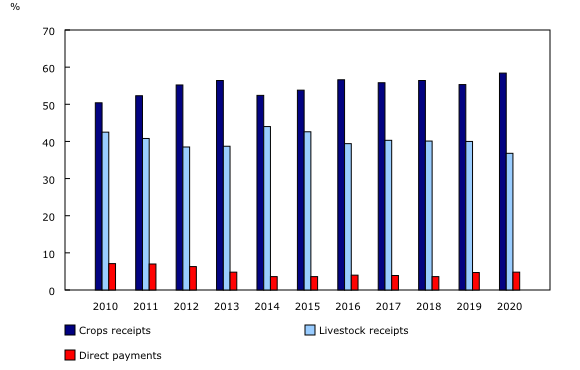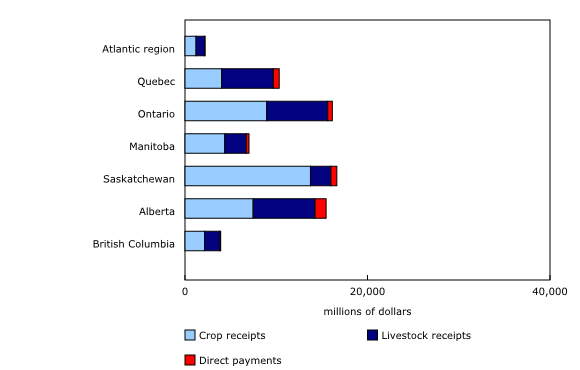Farm cash receipts, January to December 2020
Archived Content
Information identified as archived is provided for reference, research or recordkeeping purposes. It is not subject to the Government of Canada Web Standards and has not been altered or updated since it was archived. Please "contact us" to request a format other than those available.
Released: 2021-03-02
$71.7 billion
January to December 2020
8.1% 
(year-over-year change)
Canadian farmers received 14.2% more from crop sales in 2020 compared with 2019, partly because of higher exports and prices. On the other hand, they earned 0.8% less in livestock revenue because of reduced capacity at meat processing plants, especially during the early months of the pandemic. Direct payment programs to farmers rose 10.9% from a year earlier.
Farm cash receipts increase in 2020 on the strength of rising crop receipts
Farm cash receipts increased 8.1% to $71.7 billion in 2020. Higher crop receipts and increased program payments more than offset lower livestock receipts.
Farm cash receipts were up in seven provinces, led by Saskatchewan (+$2.6 billion) and Ontario (+$1.3 billion). These two provinces accounted for over two-thirds (71.8%) of the national increase. Receipts were down in British Columbia (-$15.9 million), Newfoundland and Labrador (-$12.3 million) and Nova Scotia (-$10.4 million).
Crop receipts rise on higher exports and prices
Farmers received $5.2 billion more for their crops from a year earlier, increasing in 2020 to $41.9 billion on higher export demand for most Canadian grains and oilseeds.
Grain exports were aided by rail companies having higher capacity to carry these commodities in the wake of lower demand and movement of petroleum products (according to the latest release on railway carloadings). This resulted in record high grain shipments by rail in 2020. Receipts were also up because favourable growing conditions allowed farmers to harvest their crops early. This was in contrast to 2019, where difficult seeding and harvesting conditions prevailed and rail disruptions occurred.
Most specialty crop receipts also increased sharply in 2020, while receipts for canary seeds and chickpeas decreased.
In 2020, canola receipts increased $1.6 billion to $10.2 billion on higher marketings (+14.8%) and prices (+3.6%). Exports of canola increased (+42.8%) to 11.8 million metric tonnes, with just over half of total canola exports attributed to China, Japan and Mexico. Domestic seed crushing also increased (+7.1%) to 10.3 million metric tonnes in 2020.
Lentil receipts rose $1.0 billion to $1.9 billion on higher marketings (+55.4%) and prices (+38.7%). Combined exports to India and Turkey almost doubled, accounting for almost half of lentil exports. India reduced its import tariff in June to allow more Canadian lentils.
Farm cash receipts for wheat, excluding durum, rose $747.4 million to $6.1 billion because of higher marketings (+15.2%). Exports of wheat were up 14.3%, with China purchasing 13.9% of Canada's total wheat exports in 2020. The expansion of China's hog herd in 2020 increased its need for feed grains following the African swine flu outbreak in 2019.
Durum wheat receipts rose by $328.9 million to $1.7 billion. Exports were up 16.9%, with Italy, Morocco and the United States accounting for just over half of total durum exports.
In the second full year of legalized recreational cannabis use, cannabis receipts rose by almost three-quarters (+73.9%)—accounting for almost one-third of the increase in total crop receipts. The demand for dried cannabis was spurred by the introduction of edibles, cannabis-based drinks and topicals in late 2019 and early 2020.
Livestock receipts edge down as a result of the pandemic
Livestock receipts edged down $205.9 million from 2019 to 2020, reaching $26.4 billion. The decrease was largely attributable to a 4.9% decline in cattle receipts, down to $8.3 billion. Dairy receipts rose 1.9% to $7.1 billion, which helped to offset the large decline in cattle receipts.
Slaughter cattle accounted for 82.5% of the overall decline in cattle receipts. The $352.4 million decrease (-5.5%) in slaughter cattle receipts was attributed to pandemic-related challenges faced by cattle processing plants in 2020, which contributed to lower prices (-3.0%) and marketings (-2.6%). International exports declined since Canada's largest export market for cattle, the United States, also faced COVID-19 outbreaks at processing facilities, resulting in temporary plant closures and slaughter backlogs.
In 2020, hog receipts were up 1.5% to $4.7 billion on higher marketings (+5.7%). Hog slaughter receipts rose $138.1 million, while international exports fell by $58.3 million on lower prices (-17.2%).
Supply-managed receipts accounted for 44.2% of total livestock revenue in 2020. Farmers posted higher receipts for milk (+1.9%), eggs (+7.2%) and chickens for meat (+0.8%), but lower receipts for turkey for meat (-4.2%).
Direct payments rise in Alberta and Quebec
Canadian farmers received $340.1 million more in direct payments compared with a year earlier, reaching $3.5 billion in 2020. Payments rose in five provinces, led by Alberta (+$214.4 million) and Quebec (+$109.5 million). Payments fell in the Atlantic provinces (-$38.2 million) and Ontario (-$25.6 million).
Crop insurance (+18.6% to $800.3 million) accounted for over half of the increase in direct payments in Alberta. The bulk of the crop insurance payments occurred in the first, third and fourth quarters of 2020 and were a direct result of more claims having been filed.
Payments from the livestock price insurance program to Alberta livestock farmers quadrupled to $111.4 million. The majority of the payments occurred from April to June, when cattle prices fell following the closures and subsequent slowdowns at processing plants because of COVID-19 outbreaks at the facilities.
In Quebec, the main drivers of the increase were provincial stabilization payments (+$90.6 million) and crop insurance (+$87.9 million). Provincial stabilization payments in Quebec were paid mostly to hog farmers because of lower prices and reduced capacity at processing plants during the pandemic.
Note to readers
As a result of COVID-19 and to provide Canadians with the most recent data, farm cash receipts will again be released on a quarterly basis. The next release will be on May 26, 2021, and will include data for January to March 2021.
Preliminary estimates of net farm income for 2020 will also be available on May 26, 2021.
All data in this release are in current dollars. Farm cash receipts measure the gross revenue of farm businesses. They include sales of crops and livestock products (except sales between farms in the same province) and program payments. Receipts are recorded when the money is paid to farmers. These do not represent their bottom line, as farmers have to pay their expenses and loans and cover depreciation.
Farm cash receipts are, for the most part, based on monthly marketings and the monthly prices of various commodities. Marketings are quantities sold, using various units of measure.
Data are extracted from administrative files and derived from other Statistics Canada surveys and/or other sources. These data are subject to revision. COVID-19 has also had some impact on normal collection operations. For certain commodities, it was not possible to collect data either in time or at all; in these cases, estimates were produced (e.g., fur, maple syrup). Revisions to these estimates will be made in future releases as data become available.
Find more agriculture and food statistics.
Support the 2021 Census of Agriculture.
Contact information
For more information, or to enquire about the concepts, methods or data quality of this release, contact us (toll-free 1-800-263-1136; 514-283-8300; STATCAN.infostats-infostats.STATCAN@canada.ca) or Media Relations (613-951-4636; STATCAN.mediahotline-ligneinfomedias.STATCAN@canada.ca).
- Date modified:



